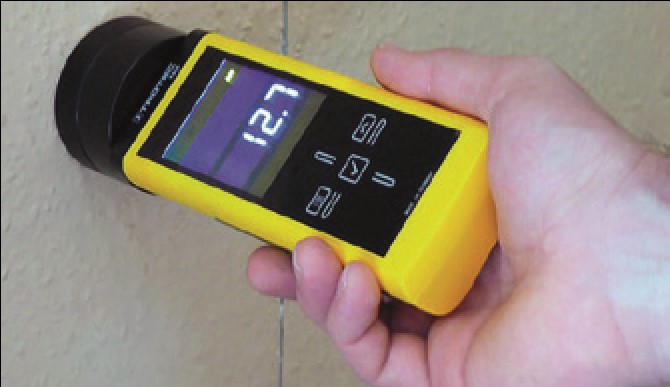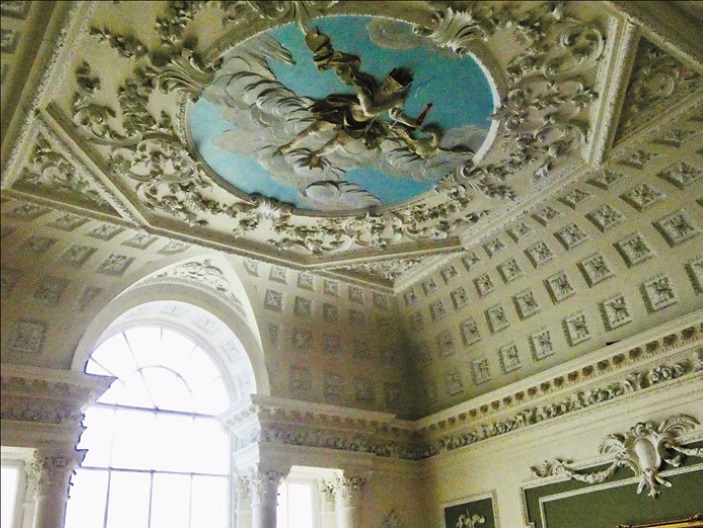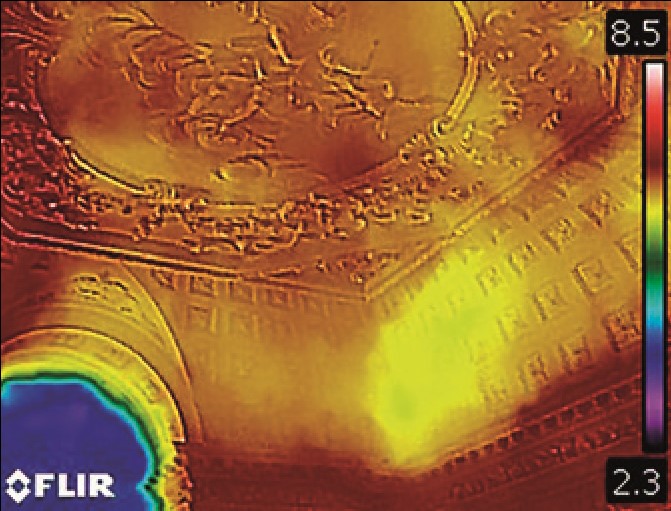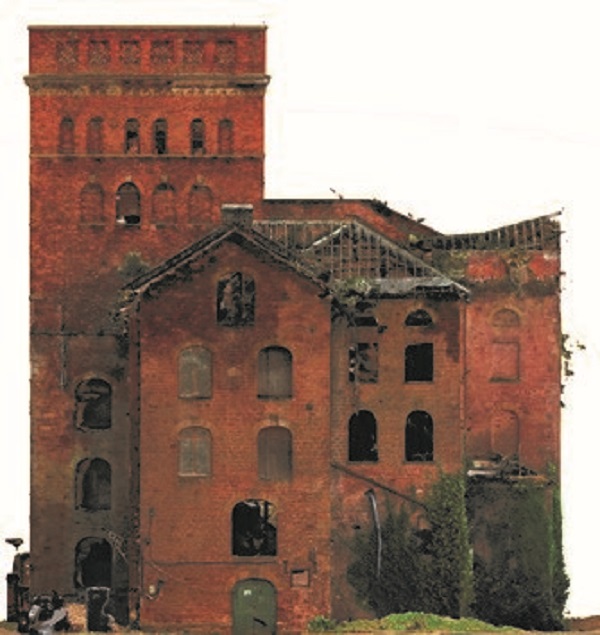Building Pathology
Established and Emerging Technologies
Lynda Jubb and Steve Bury
 |
| Visual clues backed up by hand-held moisture readings provide the basis for an hypothesis-led approach to buildings pathology |
Various new technologies are converging which provide new data for diagnosing dampness in historic buildings. These emerging technologies are allowing pathologists and other specialist surveyors to base their diagnoses on a broader range of evidence, reducing their reliance on hypothesis-based diagnostics.
Long established non-destructive moisture measurement technologies such as resistivity and capacitance meters have certain weaknesses, while the analysis of core samples (using gravimetric moisture analysers for example) has the drawback that sample-taking is a destructive process.
Resistivity meters are designed to measure the reduced resistance in a current between electrodes in damp timber. However, they are less useful for masonry and they tend to overestimate dampness in the presence of salts where the resistance is further reduced. Furthermore, they only measure resistivity at the surface.
Capacitance meters measure variations in the electrical capacitance of the substrate caused by moisture content at a depth of up to 40mm and are suitable for masonry as well as timber. Capacitance readings are relative (uncalibrated) and are prone to false readings where conductive materials lie under the surface (such as foil-backed plasterboard) since these can also measurably disrupt the electric field in ways that resemble raised moisture content.
Gravimetric moisture analysers measure the weight difference between samples when fresh and once dried. This form of destructive test is preferred in BS 5250:2011 + A1 2016 Code of practice for control of condensation in buildings, not least because samples taken from different depths and locations in a structure can provide a much better picture of moisture movement through it. These small, automated instruments can be used on site to dry and weigh samples quickly, for immediate analysis of moisture content, but the kiln-drying of samples to assess moisture content by weight is arguably simpler and safer. Both rely on removing samples from the building which are then destroyed, and the collection of a suitable number of samples can be highly invasive.
An alternative approach is to insert timber dowels into bore holes as their moisture content is much more easily measured using resistivity meters, either on site or in the lab. However, the boring process is also destructive, and the technique requires an interval between embedding the dowels and measurement, which makes it unsuitable for use in single visit inspections. The development of litmus dowels helps with fungus detection by indicating chemical changes at depth, such as the production of oxalic acid by dry rot mycelium as it probes for nutrition.
 |
| A microwave moisture meter – one of the emerging technologies which is providing more reliable data on conditions at depth in masonry |
The detection of fungus using visual clues and odour is another useful indicator of moisture content. For some people the odour of fungi such as dry rot (Serpula Lacrymans) is particularly noticeable, but for others some training is required, while sniffer dogs, or ‘rot hounds’ as they are fondly known, have an even greater sensory range.
Most surveyors who specialise in conservation will have been trained to be sceptical about hand-held moisture measures and will either rely heavily on observations (including visible signs, touch and smells) within an essentially hypothesis-led approach. The 2015 BRE paper Diagnosis of Damp tends to be heavily hypothesis-led, looking at construction and investigating details, and this approach to pathology has become ingrained largely because conventional moisture meters are so unreliable. Building practices too have been based on hypotheses that are now considered crude and simplistic, including invasive damp-proofing practices and, more recently, retrofitting measures designed to achieve high levels of insulation.
Emerging technologies are allowing building pathologists to shift from hypothesis to evidence-based diagnostics, and to specify interventions that are better-informed.
EMERGING TECHNOLOGIES
Microwave moisture meters are bringing entirely new data to bear on diagnosis. These work on the dielectric principle; water molecules have polarity because the ions tend to arrange asymmetrically and that polarity is excited by the microwave radiation at a dielectric constant that is measurably different from masonry. Because microwave radiation can penetrate to a depth of up to 800mm in solid masonry, and is insensitive to salt content, building pathologists can now gather reliable data about the moisture content of masonry at depth using non-destructive techniques. The results, like capacitance meters, are relative but can be calibrated if the type of stone and construction are known.
Thermal imaging cameras, which also operate in the electromagnetic range, are proving increasingly useful. Pathologists have always relied heavily on inspection using visible light and are likely to continue to do so - the changes they observe, whether dimensional, refraction or pigment are usually the best and most leading evidence. Thermal imaging cameras enhance the visible light spectrum in two ways; firstly, variations in surface temperature which are visible at the infra-red end of the spectrum are recorded by the camera as a thermal image; and secondly, the camera may be calibrated to record surface temperatures in absolute terms, with an accuracy of about 2°C or 2% achievable on even the most affordable models allowing the accurate identification of dewpoint locations.
Variations in surface temperature are significant because moist masonry will tend to heat up or cool down sluggishly. So, as long as the ambient temperature is changing in the area under observation, say at dawn or dusk externally, or when the heating is turned off or on internally, the thermal performance of an otherwise uniform surface will be disrupted and the variations will be visible in the thermal image. Even in reasonably static circumstances, a damp but drying wall will tend to be cooler due to the evaporation of moisture. Thermal image diagnoses are most accurate where the source of moisture is condensation.
Thermal images require some skill to interpret, but the equipment and principles are relatively simple to master as surveyors are already adept at recording using visible light images, and most infrared cameras tend to capture the visible and non-visible light side by side.
The rendering or colour scale of images can be set to highlight the dewpoint temperature for the temperature relative humidity of the room. This means that condensation events, which are sometimes very short-lived or marginal effects, can be caught by prolonged and repeated observations as the conditions change. Remote detection of temperature and humidity is the established method for these longitudinal studies, which are enhanced by sensitive thermal imaging cameras. When creating an evidence base, building pathologists can introduce a set of forced conditions to the temperature and humidity, emulating the seasonal and diurnal ranges to help identify the circumstances in which the condensation risk occurs.
DATA MANAGEMENT AND MODELLING
 |
| A thermal image taken at Lytham Hall, Lancashire investigating variations in the surface temperature of the Guiseppe Cortese plaster ceiling while planning repairs to the roof and internal gutter above (Both photos: Jubb Clews Ltd) |
 |
Recording exactly where images and moisture measurements have been taken has, in the past, been difficult or required identifying markers to be attached to buildings. This is undesirable where the surface finishes themselves are important and the study is examining moisture variations in the substrate. Accurately recording the position of all the data we collect is essential not just to eradicate bias in the data sets, it is essential to enable reliable storage, management and presentation. Improved setting out systems mean the monitor locations can be fixed in truly non-destructive ways and these rely heavily on advances in building modelling.
The relatively low cost of large-sensor digital cameras coupled with image recognition software innovations and the sheer number-crunching capability of even an average processor, has brought photogrammetry back to the fore for 3D modelling. Laser scanners had for some time provided the best way of measuring a building in 3D, because early photogrammetry techniques tended to be time-consuming and cumbersome to use. Scanning is still preferable for many applications, and is merging with photogrammetry. The leading trend in laser scanner development has been to add better cameras that record images through 360° and capture HDR imagery to increase the quality of colourised point clouds. Thermal imaging capabilities have also been added to some laser scanners further converging the reflected radiation technologies.
Commercial grade drones equipped with high-end photographic cameras, thermal imaging cameras, or even probes equipped with measuring sensors, allow these virtual models to include areas that were, until recently, extremely difficult to reach and next to impossible to accurately gather data from. The areas that have been monitored have tended to be the most accessible, but many of the most serious problems occur out of sight such as on rooftops, at the top of high walls, in floor voids or in other confined spaces.
Even inside buildings drones are proving their usefulness; ones with external protective cages are now becoming available that can literally bounce off the walls as they fly through a dangerous building or confined space gathering measurements.
BIM (building information modelling) software can be used to integrate technologies such as laser scanning, photogrammetry, moisture readings and thermal imaging, creating powerful graphic data models that can be shared and interrogated through different media such as fly-throughs, animations and web shares. Time-lapse video animations combining precise laser scanned point clouds with photogrammetry can be used to provide easily understood photo-realistic 3D models that are an ideal platform for accurately displaying thermal imaging and moisture content. These allow building pathologists to consult with a wide circle of experts and stakeholders.
Integrated data models allow the viewer to turn the datasets on and off in much the same way as we currently use 2D layers on public GIS viewers. Storing video and 3D mesh models for viewing online through a standard web browser makes the information easily accessible to a geographically scattered team.
3D formats are already embedded in the property and construction sectors. BIM software suites such as Revit are the default 3D tools to model and document buildings, but their usefulness for many heritage projects is limited partly because their functionality is based around designing new buildings, and partly because the conservation community lacks experienced users.
This creates an exciting arena in which building pathologists can create a merged live and virtual laboratory. Much work has been done by the SPAB and Historic England to compare predictive building performance software such as WUFI and RdSAP with real life outcomes, concluding that real life performance is difficult to model with existing software.
Data collation and storage is the area of biggest change and challenge. Many buildings have already been scanned to 3D point clouds and inserted into BIM models such as Revit onto which moisture readings (some at depth) can be modelled, but it is doubtful whether these models remain ‘live’ documents or become accessible to pathologists.
TAKE UP
Three identifiable drivers are overcoming the challenges in the adoption of these technologies for historic environments; consumer appetites, the policy environment and practice standards.
In terms of consumer appetite for improved pathology, most people are aware that moisture in buildings causes deterioration of materials, chiefly by timber decay, corrosion of embedded metals (in particular ferrous metals) and stone erosion (by salt crystallisation and frost action). In extreme cases, this can lead to structural failure, but mostly the lifecycle of the elements is shortened and early replacement is required. For historic buildings, this means that the building’s importance, significance or authenticity are impaired. Where the erosion is to an element that also has artistic interest, such as panelling, carvings and fine furnishings, the loss is all the more regrettable. Demand for environmental monitoring therefore tends to be led by organisations that manage large and sensitive collections or interiors, while in the residential sector demand is often driven by concerns for health and wellbeing, as dampness can support molds such as Aspergillus which are known to cause breathing difficulties for some.
 |
| A rectified photograph of Tonedale Mill extracted from visible light drone footage to record both condition and metric data (Image: Jubb Clews Ltd) |
Commercial factors will inevitably determine which emerging technologies appeal to clients’ budgets. The cost of equipment and ease of use are the most obvious factors, meaning that even relatively unreliable moisture measurement techniques, such as resistivity meters, are still very widely used. Microwave moisture meters are currently about ten times as expensive and require some skill to interpret, so take-up is slower. Thermal imaging on the other hand is cost effective and similar enough to the interpretation of visible light images that takeup has been good.
Clients are increasingly prepared to invest in remote monitoring and re-inspection because they understand the value of more than one data set in evaluation. Many are also increasingly participative in the diagnostic process, and informed about how good investigation can avoid costly, disruptive and potentially futile interventions.
In terms of policy, destructive testing is generally considered the last resort for historic environments. Emerging technologies in non-destructive testing allow regulators to take a tougher line when examining evidence to justify destructive tests. Furthermore, the practice of carrying out surveys quinquennially is becoming more common, providing reliable baseline data which can avoid the need for further investigation and unnecessary interventions – or equally, it may trigger investigations in a timely and informed way.
Historic England, Historic Environment Scotland and others have invested heavily to provide a knowledge base about nondestructive testing and monitoring, and practice standards are evolving to build on that knowledge base. The RICS is jointly publishing new guidance around the diagnosis of dampness for historic buildings with key partners from the heritage sector, placing heavy emphasis on monitoring and building the evidence base. Although hypothesis-led diagnosis is likely to remain the primary diagnostic method in the mainstream, emerging technologies allow building pathologists to move to evidence-based diagnosis in complex cases, most particularly for historic buildings. Practitioners will need to work together to join up the measurement and building pathology disciplines, by investing heavily in training and skills sharing.
The historic environment community as a whole will also need to work together on the practical and ethical challenges posed by data storage and access issues. Heritage assets are managed best where their survey and maintenance records are available as a shared resource, but the range and volume of data held on local authority HERs is becoming unsustainable on a not-for-profit basis. Private sector solutions on the other hand, expose the historic environment sector to the risk of ‘data hostaging’ if inadequately resourced. The collection and storage of great data requires a commitment to costs and trust that it will be well curated. Getting a line into curators’ budgets for such work will depend on whether the data and learning outcomes are going to be freely shared, or whether private owners, say, for commercial or security reasons, need the data to be protected.
Shared access to heritage data would also allow stakeholders to draw broader conclusions about the state of the historic built environment. However, limiting data to highly-valued heritage assets only (whether in terms of significance or monetary value) would exclude the majority of historic buildings and, in turn, those buildings’ users, reducing the value of the resource.
Owners’ appetite for evidence-based diagnostics, and practitioners’ skills set to provide them, are thus only part of the story. The historic environment sector also needs to work together to overcome the challenges that curating the data freely and fairly present. This seems a worthwhile endeavour, because if converging technologies do transform building pathology practices, there will be far reaching benefits for the whole historic environment.



